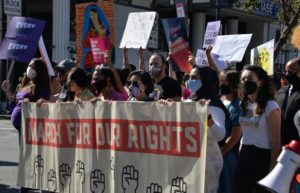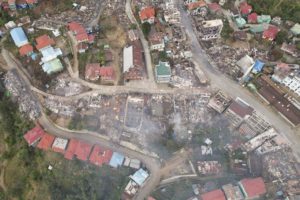A new lesson plan centers Native American perspectives on the violence of Western expansion
For thousands of years, Indigenous people inhabited and relied on the natural resources of the area now known as Northern California. Then, in 1848, a rush of Americans, Europeans and others descended on the region after the discovery of gold flakes in a local river. These migrants ascribed a high value to the rare mineral, leading many more people to arrive in the frenzied search for wealth—and violently eliminate those they saw as competition. They perpetrated government-supported violence, denied Natives equal rights in law and created a system of enslavement, child abduction and forced assimilation.
That is the story of the California Gold Rush.
Why Do We Vote on Tuesdays?
But for almost 200 years, this series of events has been taught in American schools predominantly as a victory of humans over land, of successful mineral extraction for human profit. In that telling, in January 1848, carpenter James Marshall found flakes of gold while building a water-powered sawmill for John Sutter along the American River, around 50 miles from modern Sacramento.
An influx of “49ers” arrived in the following year to prospect for gold and create businesses around the nascent mining industry, which created an economic boom for the new American territory and ushered in its statehood in 1850. Just days after Marshall’s discovery, California territory had been signed over to the U.S. by Mexico with the end of the Mexican-American War—a twist of fate that aligned perfectly with the U.S. policy of Manifest Destiny, the belief in the American right to conquer and expand across the continent.
Until recent years, the story of how this period affected California’s Indigenous peoples had largely gone untaught or underrecognized. The education team at the Smithsonian’s National Museum of the American Indian hopes to change that with its recently published online lesson, “The Impact of the Gold Rush on Native Americans of California.” Designed for grades 8-12, the lesson plan is part of the museum’s Native Knowledge 360 initiative. The inquiry into primary sources, maps and historic photographs asks students to examine the materials and answer whether American actions against California Natives during the Gold Rush meet the United Nations definition of genocide.
The team asks, “Where are the narratives missing or untold or wrong?” says Irene Kearns, a Smithsonian education specialist who helped to develop the lesson. “California really had a large hole in any sort of social studies curriculum in the past, and so they started with that premise.” The Gold Rush lesson took four years to develop in partnership with scholars, teachers and tribal leaders, in a process of “respectful” relationship-building, Kearns says. When it comes to reframing these narratives, “you have to give the care that it needs and not be extractive in the experience.”
“People are ready. They were waiting for years—hundreds of years—for this to come out, and people have been overwhelmingly positive,” says Kearns, a citizen of the Federated Indians of Graton Rancheria (Coast Miwok and Southern Pomo), who are based in Marin and Sonoma counties. “In California, the scholarship is longstanding about the Gold Rush, and now moving it into K-12, that’s a little newer, but I think people are open-minded more so than ever.”
Historian Stephen Aron, who has taught and written about the American West and the Gold Rush, and is now head of the Autry Museum of the American West, says scholarship has “shifted over the last several decades,” with new understandings of genocide and settler colonialism displacing previous narratives. “It used to be told as the triumphant story of the ‘winning of the West,’” he says, “in which the California Gold Rush figured as a heroic adventure that then transforms the Pacific slope into an American place.”
It was an example of “the American dream realized, people being able to go out and strike it rich,” he says. The focus now is on “the cultural, demographic and ecological costs associated with American conquest and colonization,” Aron notes, with “more attention also to the West as a multiethnic, multiracial place.”
Kearns sees the same changes in primary education: “There has been a shift. There’s been a real effort in including Indigenous voices in state history and these lessons, which is great. It’s a long time coming.”
An estimated 300,000 settlers arrived during the Gold Rush, which peaked in 1852. According to historian Benjamin Madley, California’s Native population plummeted from around 150,000 to 30,000 people between 1846 and 1873. The primary source documents in the lesson explain how this inverse relationship was the result of an intentional policy of genocide.
The words of an address given by California Governor Peter Burnett in 1851 are clear: “That a war of extermination will continue to be waged between the races, until the Indian race becomes extinct, must be expected.” In 1852, California Senator John Weller said: “Humanity may forbid, but the interest of the white man demands their extinction.” The state spent the modern-day equivalent of millions of dollars on military “suppression of Indian hostilities.”
The lesson pairs these statements and policies with horrific first-person accounts of Native massacres, including Sally Bell’s of the Massacre at Needle Rock: “Then they killed my baby sister and cut her heart out and threw it in the brush where I ran and hid.” Lucy Young’s eyewitness account ends: “Build big fire, burn all them bodies.”
As part of the state’s history curriculum, many elementary school students used to pan for gold as a learning activity, glossing over its devastating effects for Native people and the environment. “I went panning for gold in my tribal homelands,” Kearns recalls. Similarly, fourth-grade students were instructed to create a diorama of the Spanish missions established throughout the state from the late 1700s. As an exhibition at the Autry Museum explains, Indigenous communities faced violence and forced labor in the missions along El Camino Real, a route connecting the many Spanish settlements. For a university midterm assignment, Aron often asked his students to write about how they would redo a fourth-grade diorama with their new understanding of California history.
The lesson plan encourages students to analyze conflicting perspectives and sources from the past, and to consider how modern perspectives inform that understanding. To this end, the lesson includes a modern artwork by Harry Fonseca that provides a lens to look at the Gold Rush’s aftermath. Fonseca’s painting from the “Discovery of Gold in California” series is a dripping, mixed-media piece flecked with mica and dirt. The late Nisenan Maidu artist described it as an “explosion”: “cultures coming together, conflicting; a profusion of greed, of loss; massive change … The damage inflicted during that chaotic time was extensive. It injured the land and the living things that were there, Native Americans, and other peoples as well.”
The Gold Rush mines in the Sierra Nevada and Klamath Mountains contaminatedwater and soil, and the development of hydraulic mining produced sediment that clogged rivers and destroyed crops through flooding. These devastating environmental effects also exacerbated water conflicts in the state between mining and agricultural interests. Understanding the ecological effects of human history is another vital aspect of the Gold Rush’s legacy as California grapples with environmental damage in a changing climate.
“For Indigenous populations in California, we’ve known this. It can be heavy; it can be emotional,” Kearns says. But “kids are primed for fairness. They want to know the truth,” she adds. “The reason we teach these hard histories … is that we don’t want these to be repeated. We want to learn from history.”
“We’re still here, we survived, and our culture still carries on,” Kearns says. “We just want to share that history and we want people to know that is part of our U.S. story.”
Get the latest on what’s happening At the Smithsonian in your inbox.




